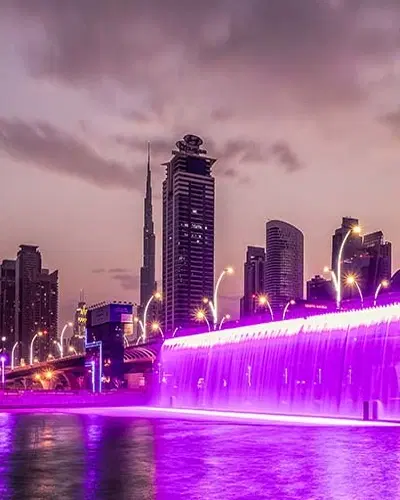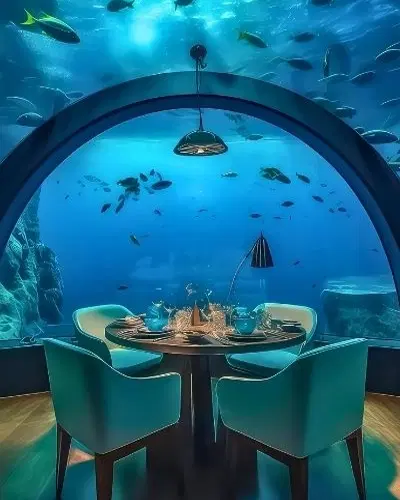Restoring Old Dubai through real estate entails reviving and maintaining the city's oldest neighbourhoods and landmarks' historical, cultural, and architectural heritage. This strategy combines the objectives of upholding economic growth, fostering sustainable tourism, and protecting cultural identity.
Let’s embark on our journey of restoration through these old neighbourhoods of Old Dubai.
Al Fahidi Historical Neighborhood (Al Bastakiya)
The historical neighbourhood of Al Fahidi also known as Al Bastakiya is one of Dubai's oldest neighbourhoods dating back to the early 19th century. To revive the cultural heritage of the city, this neighbourhood has undergone extensive restoration. The primary aim of the restoration was to preserve the authenticity of the original structures with some additions to it like art galleries, cafes, boutique hotels and museums.
Traditional wind-tower architecture keeps the buildings cool in the scorching desert climate. The historical architecture is showcased by the use of wood, coral and stone for the construction of the buildings. The wind tower is the unique feature that captures the natural air and sends it into the building, keeping it cool all throughout.
The narrow alleys add a distinctive feature to the neighbourhood. The antique buildings, the traditional art galleries and the sand-coloured small homes transport you to a primitive era. These tiny alleys create shades from the scorching sun and add a little seclusion to the place. Most of the renovated homes are now turned into museums, art galleries and cultural institutions. The artefacts depict the past history of old Dubai along with contemporary Emirati artwork.
Heritage tours are conducted to enlighten visitors about the historic past of old Dubai. The visitors can take a walking tour to stroll through each and every alley and building to understand and know about its traditional past.
The cafes and souks of these neighbourhoods are the ideal places to relish the local culture and cuisines. Visitors taste the delectable local dishes in these cafes to get an immersive unique experience. The coffee Muesuem is worth a visit for coffee lovers.
The various events and exhibitions hosted at Al Fahidi exhibit the rich culture and heritage of old Dubai.
Dubai Museum (Al Fahidi Fort)
Al Fahidi Fort is one of the oldest buildings in Dubai. The renovation and maintenance of the fort is a testament to the preservation of the rich architectural heritage.
The fort is a historical structure and one of the famous monuments in Dubai. The fort was created as a defence against attacks and battlements. The fort protects the city's important trade routes and ports of Dubai Creek. It is a historical landmark attracting visitors to explore the cultural revolution of Dubai's past present and future. The Fort creates a nostalgic ambience wandering through its narrow alleys, ancient streets and heritage buildings.
In the later years, it debuted as the Dubai Museum. A plethora of exhibits are presented showcasing the dioramas and artefacts. The traditional weaponry, clothing and household materials from the past are on display for visitors to know about Dubai’s past.
The huge interactive displays highlighting the rich cultural heritage and infrastructure, and various multimedia presentations are laid out for visitors to learn about ancient Dubai.
The educational programs and guided tours help the visitors to learn about the cultural heritage of the city.
Jumeirah Mosque
With the pious motto of Open Doors, Open Minds", the famous Jumeirah Mosque, is open to people of all religions and cultures. One of the master strokes of the Dubai government was the renovation of this mosque to ensure that the mosque was well preserved and maintained.
Constructed with pure white stone for its minarets, Arches and elaborate domes, the mosque is one of the famous monuments in old Dubai. Built-in fatimid style, this monument showcases the elegant craftsmanship of the artisans. The domes of the mosque are inspired by ancient Egyptian structures.
People from all across the world irrespective of caste and creed are allowed to visit this holy place and enjoy the various programs of cross-cultural activities. The photography enthusiasts find the serene surroundings of the mosque an enticing place to click photographs.
Guided tours are conducted to enlighten the visitors with the culture and architecture of the traditional Islamic world.
But certain etiquettes need to be followed while visiting the mosque. It is always advisable to wear modest clothes and women should keep their heads covered with a scarf while entering the mosque.
Al Shindagha District
The historical district of Al Shindagha is situated close to Dubai Creek. The entire neighbourhood of Al Shindagha is converted into an open-air museum to preserve Dubai’s history and heritage. The museum offers a location for projects involving investment and development in history and culture.
The district is famous for its architectural heritage, the residence Al Maktoum and watchtowers and mosques. With 22 pavilions having 80 historic houses, the museum is worth a visit.
The Historical Document Centre is loaded with artefacts and documents related to Dubai’s history. The restoration of these prominent places and historic buildings in modern innovative ways enriches the cultural heritage of the city.
The various spaces of the museum like the Perfume house exhibit the traditional sweet small of the Emirates. The various events and exhibitions showcase a perfect blend of traditional history with rich modern culture.
Shindagha's shoreline has been built to offer various recreational facilities to visitors. People may take in the beautiful views of Dubai Creek thanks to parks, walkways, and lounging places.
Dubai Heritage House
To preserve the rich cultural and structural heritage of Old Dubai, the Heritage House was renovated. This magnificent building, which can be found at Al Ahmadiya in Deira, is a beloved example of the city's architectural history and a relic from the past.
Heritage House is the ancient residence of the Al Maktoum family. The exemplary structure reflects beautiful architecture and design. it reflects the Emirati lifestyle with majlis(sitting areas), kitchen, courtyard and bedroom.
It provides an insight into the customs and traditions of Emirati society. Several workshops and events are conducted highlighting Emirati culture and heritage.
Textile Souk
Strategically positioned along the Creek in Bur Dubai, it gives a captivating view of the pristine waters and magnificent traditional architecture. Being an international hub Textile Souk adds a great income to Dubai’s commerce. The trade-in Dubai's souks has a long history in the Persian Gulf region, and they have grown over time as the city has increasingly urbanised.
It is a covered alleyway filled with tiny merchants selling their wares. Textile Souk is a traditional marketplace that offers an array of the finest fabrics and patterns from around the world. from silk to synthetic, wollen to cotton ready-to-wear outfits, and fabric material. abayas, kanduras, and shaylas are also available to enjoy the Emirati style of clothing. The visitors get the flavour of authentic Emirati culture in the textile souk while exploring the wide variety of fabrics and garments.
Traditional handicrafts with intricate designs are all available for home decor. unique souvenirs and heritage wares are available in the textile souk for the visitors.
The traditional architecture and ambience of the Textile Souk are taken care of while bringing in renovation and restoration of its cultural heritage. Real estate can play a significant role in the renovation of the architecture and design of the souk. With renovated vendor stalls, the display of items seems effortless and impressive. Ample of lights and display boards can further add to enhance the restoration of these traditional souks. Modern amenities with waste management make these souks more appealing.
Gold Souk
Dubai, the golden city has a famous gold souk in the Deira district, where visitors buy and sell gold. These souks, which are renowned for their bustling markets and commerce, have preserved their classic appeal while also incorporating contemporary business methods.
This economic activity brings in money for the city, which can be used for cultural initiatives and projects like heritage restoration. Numerous people from various backgrounds attend gold souks.
Cultural interchange and understanding are fostered by interactions between locals and visitors, which are crucial for protecting cultural assets.
The character and cultural landscape of Dubai are inextricably linked to its gold souks. Dubai strengthens its cultural history and identity by preserving and developing these historic markets.
Spice Souk
To enjoy the aromatic experience, visitors enjoy the Spice Souk. Located in the Al Ras area of Deira, the aroma of cinnamon, red chilli, incense, dry fruits and tea is spread across the alleys and pathways of the Spice Souk. The visitors buy baskets full of spices from these souks.
Renovation of the spice souk involves preserving the authenticity of the spices, and their cultural significance. To preserve the cultural heritage of old Dubai, these renovations involve constructing the souk's infrastructure in more walkable ways with innovative ideas, such as the pathways, lighting, and seating, to make it more convenient for visitors.
The stalls are upgraded and made aesthetically appealing keeping traditional culture intact. Various displays depicting the detailed history of the spices along with their uses help the visitor to understand the culinary traditions of the city. Spice Souk is an integral part of the community, its traditional charm is revived and well-maintained.
The Dubai Opera
This breathtaking architectural wonder of Dubai, the Dubai Opera, features performances of the highest calibre and is designed like a dhow. The iconic building has an exterior resembling the dhow’s hull. Glass panels are used for the design of the facade of the Opera.
The design honours Dubai's maritime history while showing its deep cultural origins. The Opera has an extensive Plaza area for people to gather for outdoor activities and exhibitions. It gives a stunning view of the Dubai Fountain and the Burj Khalifa from the facade. The interior is designed such that maximum sound quality and clarity can be ensured during the musical performances.
It provides a stage for performers from all around the world, enhancing Dubai's cultural diversity. The skylights allow ample natural light to filter in and create a visually captivating atmosphere of the surroundings. Dubai Opera is a perfect blend of traditional and contemporary designs.
The appealing monument is one of the famous monuments in Dubai worth visiting. From classical music to Opera and ballet Dubai Opera House gives a world-class experience of the vibrant culture of Dubai.
While not a designated heritage site, this area was created to include traditional Arabian architectural features. It sponsors cultural and creative activities, which helps to protect Dubai's overall cultural identity.
Parting Words
Old Dubai can maintain its cultural character, draw visitors looking for unique experiences, and support economic growth while preserving its rich history by combining real estate development and heritage preservation.






